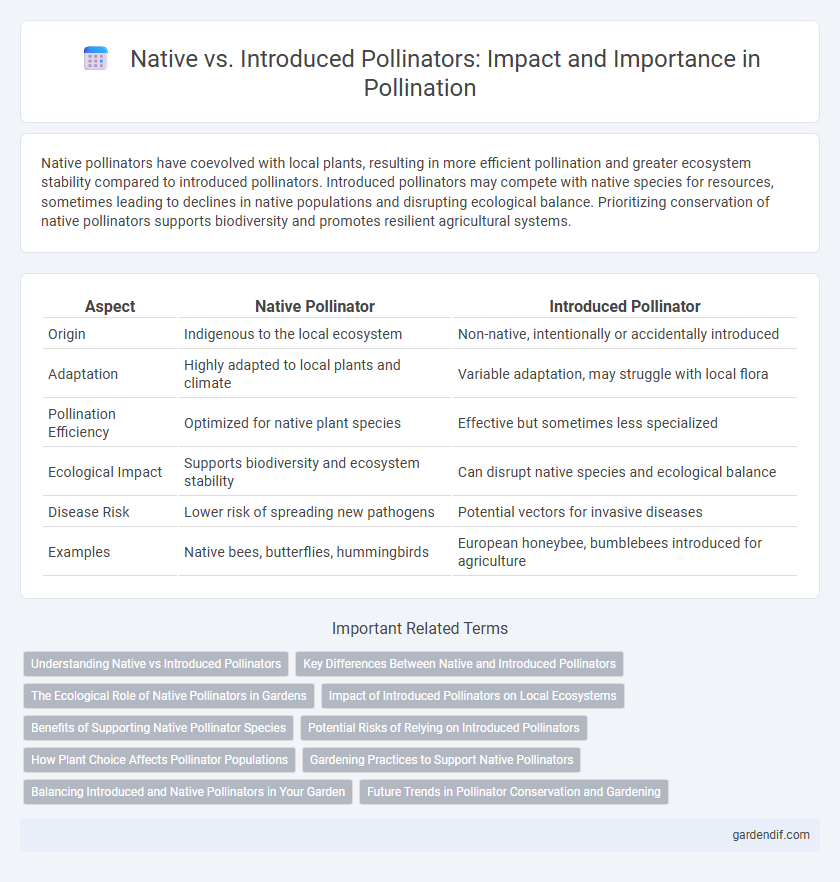
native pollinator vs introduced pollinator Illustration
Native pollinators have coevolved with local plants, resulting in more efficient pollination and greater ecosystem stability compared to introduced pollinators. Introduced pollinators may compete with native species for resources, sometimes leading to declines in native populations and disrupting ecological balance. Prioritizing conservation of native pollinators supports biodiversity and promotes resilient agricultural systems.
Table of Comparison
| Aspect | Native Pollinator | Introduced Pollinator |
|---|---|---|
| Origin | Indigenous to the local ecosystem | Non-native, intentionally or accidentally introduced |
| Adaptation | Highly adapted to local plants and climate | Variable adaptation, may struggle with local flora |
| Pollination Efficiency | Optimized for native plant species | Effective but sometimes less specialized |
| Ecological Impact | Supports biodiversity and ecosystem stability | Can disrupt native species and ecological balance |
| Disease Risk | Lower risk of spreading new pathogens | Potential vectors for invasive diseases |
| Examples | Native bees, butterflies, hummingbirds | European honeybee, bumblebees introduced for agriculture |
Understanding Native vs Introduced Pollinators
Native pollinators, such as local bees, butterflies, and birds, play a crucial role in maintaining ecosystem balance by efficiently pollinating indigenous plants they co-evolved with. Introduced pollinators, like the European honeybee, can compete with native species for resources and potentially disrupt local plant-pollinator interactions. Understanding these dynamics helps inform conservation strategies that protect native biodiversity while managing the impacts of non-native species.
Key Differences Between Native and Introduced Pollinators
Native pollinators, such as bumblebees and monarch butterflies, have co-evolved with local plants, creating a highly efficient and specialized pollination system that supports biodiversity and ecosystem stability. Introduced pollinators, like the European honeybee (Apis mellifera), often compete with native species for resources and can disrupt native plant-pollinator relationships, sometimes leading to declines in native pollinator populations. Understanding these differences highlights the importance of conserving native pollinators to maintain ecological balance and ensure long-term agricultural productivity.
The Ecological Role of Native Pollinators in Gardens
Native pollinators such as bees, butterflies, and hummingbirds play a critical ecological role in gardens by promoting biodiversity and enhancing the reproduction of native plants. They have co-evolved with local flora, resulting in more efficient pollination compared to introduced species, which may disrupt existing ecosystems or compete with native pollinators. Supporting native pollinator populations strengthens ecological resilience, ensuring long-term sustainability and healthier garden habitats.
Impact of Introduced Pollinators on Local Ecosystems
Introduced pollinators often disrupt native pollinator populations by competing for resources and spreading diseases, leading to declines in local biodiversity. Studies reveal that invasive species such as the European honeybee (Apis mellifera) can alter pollination networks, negatively affecting native plants that depend on specialized pollinators. The imbalance caused by introduced pollinators ultimately compromises ecosystem resilience and the reproductive success of endemic flora.
Benefits of Supporting Native Pollinator Species
Supporting native pollinator species enhances local biodiversity and ecosystem stability by promoting co-evolved plant-pollinator relationships crucial for successful pollination. Native pollinators are better adapted to regional climates and flora, increasing pollination efficiency and crop productivity compared to introduced pollinators. Conserving native species also reduces risks of disease spread and competition that often accompany non-native pollinators, preserving ecological balance.
Potential Risks of Relying on Introduced Pollinators
Relying on introduced pollinators such as honeybees can disrupt local ecosystems by outcompeting native pollinators for resources, leading to declines in indigenous species diversity. Introduced pollinators may also carry pathogens or parasites unfamiliar to native populations, increasing disease transmission risks. Furthermore, dependence on non-native pollinators can reduce pollination efficiency for certain native plants adapted specifically to local pollinator species.
How Plant Choice Affects Pollinator Populations
Native pollinators thrive when plant choices include local flora adapted to regional climate and soil conditions, providing essential nectar and pollen. Introduced pollinators often rely on non-native plants that may offer less nutritional value, potentially disrupting existing ecosystems. Selecting native plants supports pollinator biodiversity and enhances population stability by maintaining ecological balance.
Gardening Practices to Support Native Pollinators
Gardening practices that support native pollinators focus on planting indigenous flowering species to provide appropriate nectar and pollen sources. Avoiding pesticides and maintaining natural habitats enhance native pollinator populations, promoting biodiversity and ecological balance. Incorporating native plants also reduces competition from introduced pollinators, ensuring the resilience of local ecosystems.
Balancing Introduced and Native Pollinators in Your Garden
Balancing introduced and native pollinators in your garden enhances biodiversity and ecosystem resilience by supporting a variety of plant species and pollination needs. Native pollinators, such as bumblebees and solitary bees, are often more efficient at pollinating local flora due to co-evolution, whereas introduced species like honeybees provide large-scale pollination services but can compete with native populations. Integrating diverse floral resources and habitat features promotes coexistence, ensuring sustainable pollination and preserving native pollinator health.
Future Trends in Pollinator Conservation and Gardening
Native pollinators like bees, butterflies, and hummingbirds exhibit higher efficiency in pollinating local flora due to co-evolution, making them essential for sustainable ecosystems. Future trends in pollinator conservation emphasize habitat restoration, native plant gardens, and reduction of pesticide use to support these indigenous species. Introduced pollinators, while useful in agricultural settings, often present risks such as competition and disease transmission, reinforcing the priority to protect and enhance native pollinator populations.
native pollinator vs introduced pollinator Infographic

 gardendif.com
gardendif.com